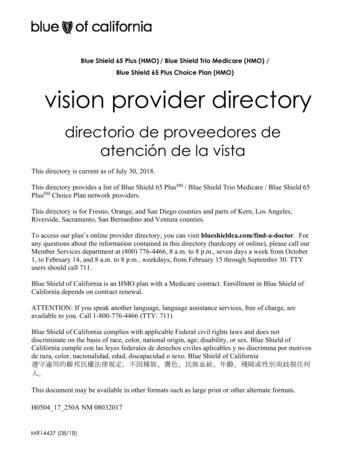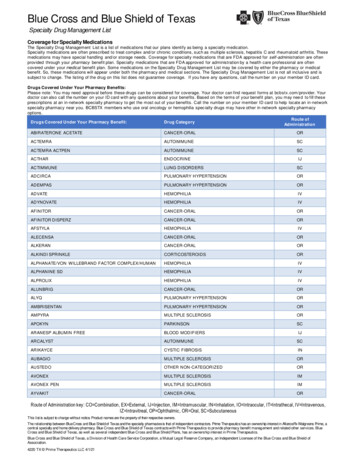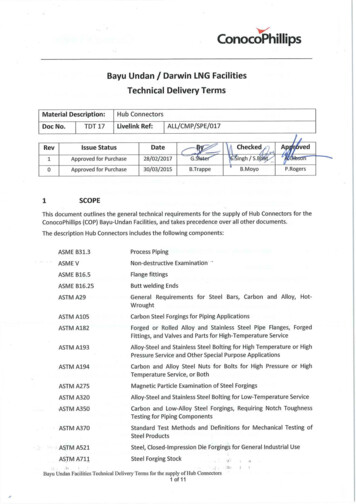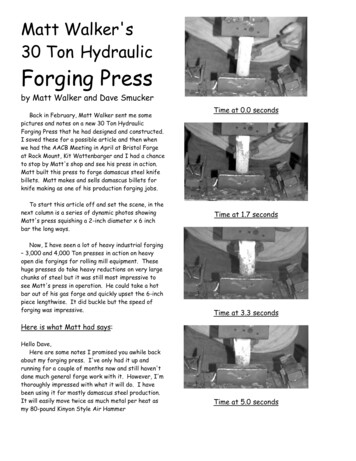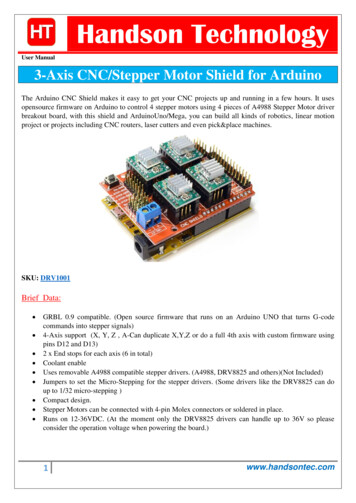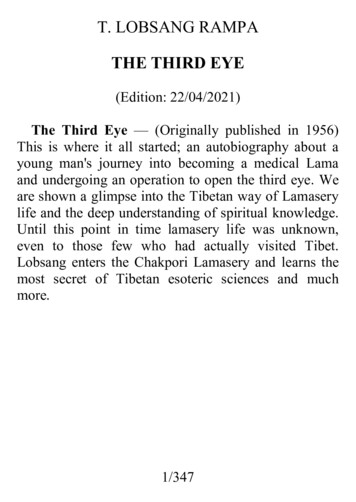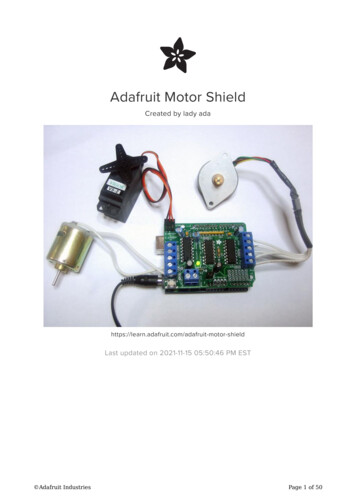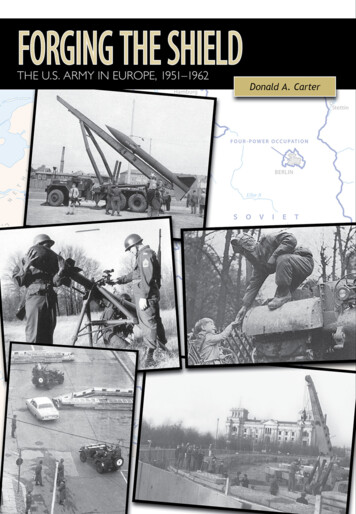
Transcription
U.S. Army in the Cold WarForging the ShieldThe U.S. Army in Europe, 1951–1962byDonald A. CarterCenter of Military HistoryUnited States ArmyWashington, D.C., 2015
Cover: (second row, right) A tanker pauses to hand out candy to German children duringOperation Sabre Knot. All other cover images are featured within the book.Library of Congress Cataloging-in-Publication DataCarter, Donald A., 1955Forging the shield : the U.S. Army in Europe, 1951-1962 / by Donald A.Carter.pages cm. -- (Army historical series)Includes bibliographical references and index.1. United States--Armed Forces--Europe--History--20th century. 2. UnitedStates. Army, Europe and Seventh Army--History--20th century. 3.Europe--Military relations--United States. 4. United States--Militaryrelations--Europe. I. Title.UA26.E9C37 2015355.0094’09045--dc23CMH Pub 45–3–12014047210
ARMY HISTORICAL SERIESRichard W. Stewart, General EditorAdvisory Committee(As of November 2014)Dr. Robert M. CitinoNorth Texas UniversityMr. Mark F. AverillDeputy AdministrativeAssistant to theSecretary of the ArmyDr. Wayne E. LeeUniversity of North CarolinaLt. Gen. Kevin W. MangumU.S. Army Training andDoctrine CommandDr. John A. NaglThe Haverford SchoolCol. David FunkU.S. Army War CollegeBrig. Gen. Christopher P. HughesU.S. Army Command andGeneral Staff CollegeBrig. Gen. Timothy TrainorU.S. Military AcademyDr. Geoffrey P. MegargeeUnited States HolocaustMemorial MuseumDr. Richard W. StewartU.S. Army Center ofMilitary HistoryU.S. Army Center of Military HistoryRichard W. Stewart, Acting DirectorChief HistorianChief, Histories DivisionChief, Historical Products BranchRichard W. StewartDavid W. Hogan Jr.Beth F. MacKenzieiii
ContentsPageForeword . . . . . . . . . . . . . . . . . . . . . . . . . . . . . . . . . . . . . . . . . . . . . . . . . . xiiiThe Author . . . . . . . . . . . . . . . . . . . . . . . . . . . . . . . . . . . . . . . . . . . . . . . . .xvPreface . . . . . . . . . . . . . . . . . . . . . . . . . . . . . . . . . . . . . . . . . . . . . . . . . . . . . xviiChapter1. Setting the Stage . . . . . . . . . . . . . . . . . . . . . . . . . . . . . . . . . . . . . . . .Germany in 1950 . . . . . . . . . . . . . . . . . . . . . . . . . . . . . . . . . . .The Emerging Threat and the Move TowardCollective Security . . . . . . . . . . . . . . . . . . . . . . . . . . . . . . .The European Command in 1950 . . . . . . . . . . . . . . . . . . . . . .Perceptions of a Rising Threat . . . . . . . . . . . . . . . . . . . . . . . .1147122. The New Mission . . . . . . . . . . . . . . . . . . . . . . . . . . . . . . . . . . . . . . .Building the Seventh Army . . . . . . . . . . . . . . . . . . . . . . . . . . .Growing Pains . . . . . . . . . . . . . . . . . . . . . . . . . . . . . . . . . . . . .Reorganization and Realignment . . . . . . . . . . . . . . . . . . . . . .Identifying the Threat . . . . . . . . . . . . . . . . . . . . . . . . . . . . . . .Firepower and Mobility: The Seventh Army’sConventional Doctrine . . . . . . . . . . . . . . . . . . . . . . . . . . .Early Thoughts on an Atomic Option . . . . . . . . . . . . . . . . . .Development of the Communications Zone . . . . . . . . . . . . . .Logistical Support for the New Mission . . . . . . . . . . . . . . . . .Berlin, 1951–1952: Standing Fast and Showing the Flag . . . .The End of the Beginning . . . . . . . . . . . . . . . . . . . . . . . . . . . .15152330343. Growing Into the Role . . . . . . . . . . . . . . . . . . . . . . . . . . . . . . . . . . .1953: The Cold War Takes a New Turn . . . . . . . . . . . . . . . . .Keeping a Watchful Eye to the East . . . . . . . . . . . . . . . . . . . .Changes in Command and Combat Readiness . . . . . . . . . . . .The Seventh Army Goes Nuclear . . . . . . . . . . . . . . . . . . . . . .Manning the Force: USAREUR’s Personnel Pipeline . . . . . .Additions and Subtractions: Organizational Changes inUSAREUR and the Seventh Army . . . . . . . . . . . . . . . . .7979838799106v405558687478116
ChapterPageHardening the Support Structure . . . . . . . . . . . . . . . . . . . . . .Settling in for the Long Haul . . . . . . . . . . . . . . . . . . . . . . . . .Noncombatant Evacuation Exercises . . . . . . . . . . . . . . . . . . .A Steadying Influence . . . . . . . . . . . . . . . . . . . . . . . . . . . . . . .1211271381424. Strengthening the Alliance . . . . . . . . . . . . . . . . . . . . . . . . . . . . . . . .Building NATO’s Military Capabilities . . . . . . . . . . . . . . . . . .Integrating USAREUR into the NATOCommand Structure . . . . . . . . . . . . . . . . . . . . . . . . . . . . .Army Support for Military Assistance Programsin Europe . . . . . . . . . . . . . . . . . . . . . . . . . . . . . . . . . . . . . .The Military Liaison Missions and the USAREURSoviet Relations Advisory Committee . . . . . . . . . . . . . . .Moving the Alliance Forward . . . . . . . . . . . . . . . . . . . . . . . . .1431435. Rearming the Germans . . . . . . . . . . . . . . . . . . . . . . . . . . . . . . . . . .Working Toward a German Contribution to WesternEuropean Defense . . . . . . . . . . . . . . . . . . . . . . . . . . . . . . .Designing a Structure for German Integration—The European Defense Community . . . . . . . . . . . . . . . . .USAREUR Planning for German Army Assistance . . . . . . .Final Plans for Training the New German Army . . . . . . . . . .Building a New German Army . . . . . . . . . . . . . . . . . . . . . . . .Completing the German Army Assistance Program . . . . . . .1716. 1955: A Year of Transition . . . . . . . . . . . . . . . . . . . . . . . . . . . . . . . .The New Look Comes to USAREUR . . . . . . . . . . . . . . . . . .Striving for Combat Readiness . . . . . . . . . . . . . . . . . . . . . . . .Operation Gyroscope . . . . . . . . . . . . . . . . . . . . . . . . . . . . . . .The End of the Occupation in Austria . . . . . . . . . . . . . . . . . .The Effect of German Sovereignty on U.S. Forcesin Europe . . . . . . . . . . . . . . . . . . . . . . . . . . . . . . . . . . . . . .Reaching an Uneasy Equilibrium . . . . . . . . . . . . . . . . . . . . . .2072072122222307. Achieving Atomic Mindedness . . . . . . . . . . . . . . . . . . . . . . . . . . . .The “Spirit of Geneva” Evaporates . . . . . . . . . . . . . . . . . . . .Eisenhower Versus the Generals: The Army Strugglesto Find a Role Within the New Look . . . . . . . . . . . . . . . .New Leadership in USAREUR . . . . . . . . . . . . . . . . . . . . . . .The Effect of Funding Cuts on USAREUR . . . . . . . . . . . . .Training for Atomic Warfare . . . . . . . . . . . . . . . . . . . . . . . . . .Pentomic Reorganization . . . . . . . . . . . . . . . . . . . . . . . . . . . .Adapting the Logistical Support Structure to AtomicWarfare . . . . . . . . . . . . . . . . . . . . . . . . . . . . . . . . . . . . . . .Complications of Alliance Defense Planning . . . . . . . . . . . . 9262264271275284
ChapterPage8. Second Thoughts . . . . . . . . . . . . . . . . . . . . . . . . . . . . . . . . . . . . . . .The “New Look” Gets a New Look . . . . . . . . . . . . . . . . . . . .Putting Pentomic to the Test . . . . . . . . . . . . . . . . . . . . . . . . . .Other Training . . . . . . . . . . . . . . . . . . . . . . . . . . . . . . . . . . . . .Rethinking Concept C and COMZ Realignment . . . . . . . . . .The U.S. Army Southern European Task Force . . . . . . . . . . .Tying Up Loose Ends . . . . . . . . . . . . . . . . . . . . . . . . . . . . . . .Managing Dependents . . . . . . . . . . . . . . . . . . . . . . . . . . . . . . .Reconsiderations . . . . . . . . . . . . . . . . . . . . . . . . . . . . . . . . . . .2952952993133193223253313339. Approaching Stalemate . . . . . . . . . . . . . . . . . . . . . . . . . . . . . . . . . .Re-evaluating the Enemy . . . . . . . . . . . . . . . . . . . . . . . . . . . .USAREUR’s Role in the American Interventionin Lebanon . . . . . . . . . . . . . . . . . . . . . . . . . . . . . . . . . . . . .The 1958 Berlin Crisis . . . . . . . . . . . . . . . . . . . . . . . . . . . . . . .Learning to Live with the Status Quo . . . . . . . . . . . . . . . . . . .33533510. Getting Along with the Neighbors . . . . . . . . . . . . . . . . . . . . . . . . . .The Transfer of Military Liaison Functions fromthe Office of the High Commissioner to theEuropean Command . . . . . . . . . . . . . . . . . . . . . . . . . . . . .Monitoring and Controlling the Message . . . . . . . . . . . . . . . .Bones of Contention: Major Points of Friction BetweenGerman Civilians and the U.S. Army . . . . . . . . . . . . . . . .Learning to Get Along at the Local Level:Orientation and Goodwill Programs . . . . . . . . . . . . . . . . .Maintaining the Relationships . . . . . . . . . . . . . . . . . . . . . . . .Fitting in with the French . . . . . . . . . . . . . . . . . . . . . . . . . . . .Charities and Disaster Relief: Being a Good NeighborWhen it Counted . . . . . . . . . . . . . . . . . . . . . . . . . . . . . . . .A Convergence of Cultures—Elvis Goes to Europe . . . . . . . .36911. The Berlin Crisis . . . . . . . . . . . . . . . . . . . . . . . . . . . . . . . . . . . . . . . .“A Bone in the Throat” . . . . . . . . . . . . . . . . . . . . . . . . . . . . . .Khrushchev Renews His Ultimatum . . . . . . . . . . . . . . . . . . .The Wall . . . . . . . . . . . . . . . . . . . . . . . . . . . . . . . . . . . . . . . . . .Confrontation at Checkpoint Charlie . . . . . . . . . . . . . . . . . . .Winding Down the Confrontation . . . . . . . . . . . . . . . . . . . . .40340340741042042712. From New Look to Flexible Response . . . . . . . . . . . . . . . . . . . . . .Looking Beyond Berlin: The Strategic Environmentin 1961 . . . . . . . . . . . . . . . . . . . . . . . . . . . . . . . . . . . . . . . .Creating a New Division . . . . . . . . . . . . . . . . . . . . . . . . . . . . .Equipping the Force for Flexible Response . . . . . . . . . . . . . .New Priorities . . . . . . . . . . . . . . . . . . . . . . . . . . . . . . . . . . . . 49
ChapterPageDistractions . . . . . . . . . . . . . . . . . . . . . . . . . . . . . . . . . . . . . . .Looking Toward the Future . . . . . . . . . . . . . . . . . . . . . . . . . .45746313. Conclusion: Defining an Era . . . . . . . . . . . . . . . . . . . . . . . . . . . . . .465Bibliographical Note . . . . . . . . . . . . . . . . . . . . . . . . . . . . . . . . . . . . . . . . .Acronyms . . . . . . . . . . . . . . . . . . . . . . . . . . . . . . . . . . . . . . . . . . . . . . . . . .Map Symbols . . . . . . . . . . . . . . . . . . . . . . . . . . . . . . . . . . . . . . . . . . . . . . .Index . . . . . . . . . . . . . . . . . . . . . . . . . . . . . . . . . . . . . . . . . . . . . . . . . . . . . .471487491493TablesNo.1. U.S. Army Strength in Europe, January 1951–December 1952 . . . . . .2. Seventh Army Logistical Support . . . . . . . . . . . . . . . . . . . . . . . . . . . .2474ChartsNo.1. Organizational Structure of the European Commandas of 31 December 1950 . . . . . . . . . . . . . . . . . . . . . . . . . . . . . . .2. Organizational Structure of the United States Army,Europe, 1 August 1952 . . . . . . . . . . . . . . . . . . . . . . . . . . . . . . . .3. Organizational Structure Seventh Army, 31 January 1952 . . . . . . . . .4. Allied Command Europe . . . . . . . . . . . . . . . . . . . . . . . . . . . . . . . . . . .113175146MapsNo.1. Occupied Zones of Germany, August 1945 . . . . . . . . . . . . . . . . . . . . .2. Seventh Army Deployment Zones, West Germany, 1951 . . . . . . . . . .3. U.S. Army, Europe, Area Commands, 1 December 1952 . . . . . . . . . .4. Primary Approaches for Soviet Attack . . . . . . . . . . . . . . . . . . . . . . . .5. European Command, Bremerhaven Lines of Communication . . . . . .6. Lines of Communication, France, 1950s . . . . . . . . . . . . . . . . . . . . . . .7. U.S. Army, Europe, Family Housing West Germany, 30 June 1953 . .8. U.S. Army Training Cadres West German Army TroopTraining Schools, 1956 . . . . . . . . . . . . . . . . . . . . . . . . . . . . . . . .9. U.S. Army Tactical and Maintenance Teams,West German Divisions, February–June 1957 . . . . . . . . . . . . .10. NATO/USAREUR War Plan, Lech-Weser Line, 1955 . . . . . . . . . . . .11. Seventh Army Command, West Germany, 1957 . . . . . . . . . . . . . . . . .12. Seventh Army Defense Lines, West Germany, 1957 . . . . . . . . . . . . . .13. Nike Missile Sites, 30 June 1958 . . . . . . . . . . . . . . . . . . . . . . . . . . . . . .14. Eastern Mediterranean Area, 1958 . . . . . . . . . . . . . . . . . . . . . . . . . . .viii22233395961130198204239286288330344
Page15. Beirut and Vicinity, Lebanon, 1958 . . . . . . . . . . . . . . . . . . . . . . . . . . .16. Berlin Crossing Points, 1961 . . . . . . . . . . . . . . . . . . . . . . . . . . . . . . . . .17. Seventh Army Dispositions in 1962 . . . . . . . . . . . . . . . . . . . . . . . . . . .18. Allied Forces, Central Europe, North Atlantic TreatyOrganization, 1962 . . . . . . . . . . . . . . . . . . . . . . . . . . . . . . . . . . .352415437438IllustrationsGeneral Thomas Handy, September 1949 . . . . . . . . . . . . . . . . . . . . . . . . .Lt. General Manton S. Eddy, August 1950 . . . . . . . . . . . . . . . . . . . . . . . .12th Infantry, 4th Infantry Division, in Dorningheim,October 1951 . . . . . . . . . . . . . . . . . . . . . . . . . . . . . . . . . . . . . . . . . . .Company A, 1st Engineer Battalion build a ferry . . . . . . . . . . . . . . . . . . .19th Infantry patrol near Hanau, October 1951 . . . . . . . . . . . . . . . . . . . .Soldiers conceal M26 tank near Hanau, October 1951 . . . . . . . . . . . . . . .V Corps Artillery Fire Support Control Center . . . . . . . . . . . . . . . . . . . .Situation map for Exercise Combine, October 1951 . . . . . . . . . . . . . . . . .Armored half track of the aggressor forces duringExercise Combine, October 1951 . . . . . . . . . . . . . . . . . . . . . . . . . . . .Field dental clinic, December 1952 . . . . . . . . . . . . . . . . . . . . . . . . . . . . . .Soldiers prepare fried chicken during a field exercise, November 1952 . . .Headquarters, 7917th Labor Supervision Detachment,Fontenet tent area, January 1952 . . . . . . . . . . . . . . . . . . . . . . . . . . . .571st Ordnance Ammunition Command, Captieux, France . . . . . . . . . . .LACM pulls up to a floating dock and crane . . . . . . . . . . . . . . . . . . . . . .USNS Pvt. Francis X McGraw at Le Tur Belle, France . . . . . . . . . . . . . . .Troops unloading at La Pallice, France, April 1953 . . . . . . . . . . . . . . . . .East German border guards and tank, 19 June 1953 . . . . . . . . . . . . . . . .Soviet tanks in Berlin, June 1953 . . . . . . . . . . . . . . . . . . . . . . . . . . . . . . . .Lt. General Charles Bolte, January 1953 . . . . . . . . . . . . . . . . . . . . . . . . . .Marshal of France Alphonse Juin and General Hoge . . . . . . . . . . . . . . . .106-mm. recoilless rifle, October 1953 . . . . . . . . . . . . . . . . . . . . . . . . . . . .Maj. Gen. James Gavin checks map coordinates . . . . . . . . . . . . . . . . . . . .Brig. Gen. Raymond Bell, Lt. Gen. Anthony McAuliffe, Maj. Gen.Ira Swift, French Gen. Marcel Carpentier . . . . . . . . . . . . . . . . . . . .43d Infantry Battalion and 67th Tank Battalion, 2d ArmoredDivision, move into attack position . . . . . . . . . . . . . . . . . . . . . . . . . .A heavy tank company from 6th Infantry in Grunewald . . . . . . . . . . . . .43d Infantry Division conducting reconnaissance with “westland”forces in Gresenhren . . . . . . . . . . . . . . . . . . . . . . . . . . . . . . . . . . . . . .Soldiers of Company K, 110th Infantry, move through the outskirtsof Gerberstein . . . . . . . . . . . . . . . . . . . . . . . . . . . . . . . . . . . . . . . . . .A 280-mm. cannon, October 1955 . . . . . . . . . . . . . . . . . . . . . . . . . . . . . . .1st Gun Section, Battery B, 59th Field Artillery Battalion . . . . . . . . . . . .Gun crew of the 91st Anti-Aircraft Artillery Battalion . . . . . . . . . . . . . . 95100101103103114
PageBattery B, 26th Field Artillery, 9th Infantry Division, October 1955 . . . .5-gallon gas cans ready for stacking . . . . . . . . . . . . . . . . . . . . . . . . . . . . . .M47 tank . . . . . . . . . . . . . . . . . . . . . . . . . . . . . . . . . . . . . . . . . . . . . . . . . .Housing project at Gelnhausen . . . . . . . . . . . . . . . . . . . . . . . . . . . . . . . . .Stars and Stripes was available in all PXs . . . . . . . . . . . . . . . . . . . . . . . . .Brig. Gen. George Rehn, General Lauris Norstad, and Maj. Gen.Dean Strother . . . . . . . . . . . . . . . . . . . . . . . . . . . . . . . . . . . . . . . . . . .General Matthew Ridgeway inspects French troops at Baderces . . . . . . .General Alfred Gruenther inspects the 2d Armored DivisionHonor Guard . . . . . . . . . . . . . . . . . . . . . . . . . . . . . . . . . . . . . . . . . . .Marshal of France General Alphonse Juin . . . . . . . . . . . . . . . . . . . . . . . .General Hodes greets General Heusinger at the HeidelbergAirstrip, 21 June 1956 . . . . . . . . . . . . . . . . . . . . . . . . . . . . . . . . . . . .German Army trainees attend class on the American carbine . . . . . . . . .An American instructor holds class on the carbine . . . . . . . . . . . . . . . . . .Small-unit tactics being taught at German ArmyOfficer Candidate School . . . . . . . . . . . . . . . . . . . . . . . . . . . . . . . . . .Engineer technique course at German Army OfficerCandidate School . . . . . . . . . . . . . . . . . . . . . . . . . . . . . . . . . . . . . . . .An Honest John and launcher at Darmstadt on ArmedForces Day 1956 . . . . . . . . . . . . . . . . . . . . . . . . . . . . . . . . . . . . . . . . .General Hart and General Hodes discuss Exercise Cordon Bleu . . . . . .Corporal missile at White Sands, New Mexico, October 1955 . . . . . . . . .Tanks from 1st Battalion, 14th Armored Cavalry Regiment,during Exercise Cordon Bleu . . . . . . . . . . . . . . . . . . . . . . . . . . . . . .Aggressor forces in Dinkelsbühl during Exercise Cordon Bleu . . . . . . . .A real injury is evacuated during Exercise Cordon Bleu . . . . . . . . . . . . .Troops board a train to Bremerhaven to take them to Kaiserslautern . . .Soldiers from the 11th Airborne Division arrive as partof Operation Gyroscope . . . . . . . . . . . . . . . . . . . . . . . . . . . . . . . . . .A soldier and his family are met by Maj. Gen. E. D. Post . . . . . . . . . . . .Aerial view of the Böblingen housing area, August 1955 . . . . . . . . . . . . .The 350th Infantry prepare to case the unit colors . . . . . . . . . . . . . . . . . .Soviet tanks in Budapest, 1956 . . . . . . . . . . . . . . . . . . . . . . . . . . . . . . . . . .Tanks and wreckages outside Killian Barracks in Budapest . . . . . . . . . . .General Taylor, 1st Lt. Robert Breckenridge, and Brig. Gen.Stanton Babcock . . . . . . . . . . . . . . . . . . . . . . . . . . . . . . . . . . . . . . . .Paul Simmon and Herman Hagen view the Nike missiledisplay at Campbell Barracks . . . . . . . . . . . . . . . . . . . . . . . . . . . . . .Secretary of the Army Wilbur Brucker and General Hodes . . . . . . . . . . .General Clarke . . . . . . . . . . . . . . . . . . . . . . . . . . . . . . . . . . . . . . . . . . . . . .A 280-mm. gun is loaded onto British raft “Alice” . . . . . . . . . . . . . . . . . .The V Corps communication center during Command PostExercise Summer Stock . . . . . . . . . . . . . . . . . . . . . . . . . . . . . . . . . . .Explosion from 3.5-in. rocket . . . . . . . . . . . . . . . . . . . . . . . . . . . . . . . . . . 7269
PageA Gun jeep with 106-mm. recoilless rifle . . . . . . . . . . . . . . . . . . . . . . . . . .SETAF’s 543d Field Artillery Missile Battalion preparesa Corporal missile . . . . . . . . . . . . . . . . . . . . . . . . . . . . . . . . . . . . . . .M59 armored personnel carrier . . . . . . . . . . . . . . . . . . . . . . . . . . . . . . . . .Soldiers board an H–34 helicopter . . . . . . . . . . . . . . . . . . . . . . . . . . . . . .Corporal erector . . . . . . . . . . . . . . . . . . . . . . . . . . . . . . . . . . . . . . . . . . . . .Corporal missile ready for launch . . . . . . . . . . . . . . . . . . . . . . . . . . . . . . .General Clyde D. Eddleman . . . . . . . . . . . . . . . . . . . . . . . . . . . . . . . . . . . .An H–34 helicopter airlifts a 105-mm. howitzer . . . . . . . . . . . . . . . . . . . .Jeep equipped with recoilless rifles attached to an H–34 helicopter . . . . .Field maintenance shop in Rheinau . . . . . . . . . . . . . . . . . . . . . . . . . . . . . .Corpsman administers Salk vaccine to U.S. dependents . . . . . . . . . . . . . .SETAF helicopter transports a small chapel to the summitof Mt. Grignone . . . . . . . . . . . . . . . . . . . . . . . . . . . . . . . . . . . . . . . . .Rear Admiral Sherman R. Clark and Maj. Gen. John P. Daly . . . . . . . . .2d ACR trooper checks an East German guard tower nearHof, Germany . . . . . . . . . . . . . . . . . . . . . . . . . . . . . . . . . . . . . . . . . .Russian military missile display . . . . . . . . . . . . . . . . . . . . . . . . . . . . . . . . .Tanks moving through Red Square . . . . . . . . . . . . . . . . . . . . . . . . . . . . . .1st Airborne Battle Group, 187th Infantry, 24th InfantryDivision unloads west of Beirut . . . . . . . . . . . . . . . . . . . . . . . . . . . .Soldiers of the 1st Airborne Battle Group move out afterlanding at Beirut airport . . . . . . . . . . . . . . . . . . . . . . . . . . . . . . . . . .Maj. Gen. Paul D. Adams . . . . . . . . . . . . . . . . . . . . . . . . . . . . . . . . . . . . .Soldiers catch up on the news in a foxhole in Beirut . . . . . . . . . . . . . . . . .A lifeguard on a stand made of C-rations watches soldiersswim in the Mediterranean . . . . . . . . . . . . . . . . . . . . . . . . . . . . . . . .“Airborne Annie” helps soldiers lay wire in Lebanon . . . . . . . . . . . . . . . .The 187th Infrantry, 1st Airborne Battle Group on patrol . . . . . . . . . . . .A German child meets a man portraying a Native Americanin Mannheim . . . . . . . . . . . . . . . . . . . . . . . . . . . . . . . . . . . . . . . . . . .Red Diamond chorus and German orphans sing Christmas carols . . . . .Santa visits the children of Friedberg Kinderheim, December 1955 . . . .Sgt. Elvis Presley briefs his reconnaissance team . . . . . . . . . . . . . . . . . . . .Construction of the wall around Brandenburg Gate . . . . . . . . . . . . . . . . .“Wall of Shame” looking from East Berlin . . . . . . . . . . . . . . . . . . . . . . . .1st Battle Group, 18th Infantry, passes Helmstedt checkpoint . . . . . . . . .1st Battle Group, 18th Infantry, waits at Helmstedt checkpoint . . . . . . . .U.S. MPs on the West Berlin side of Wilhelmstrasse . . . . . . . . . . . . . . . . .U.S. armed patrol escorts a USAREUR-registered civilianvehicle into East Berlin . . . . . . . . . . . . . . . . . . . . . . . . . . . . . . . . . . .Reinforced rifle squad preparing to set up on border . . . . . . . . . . . . . . . .Allied entry point to East Berlin at Checkpoint Charlie . . . . . . . . . . . . . .Davy Crockett in Jeep mounted mode . . . . . . . . . . . . . . . . . . . . . . . . . . . .A three-man crew prepares the Davy Crockett . . . . . . . . . . . . . . . . . . . . 22424425443444
PageLt. Gen. Garrison H. Davidson . . . . . . . . . . . . . . . . . . . . . . . . . . . . . . . . .Battery A, 1st Battalion, 2d Artillery, 8th Infantry Division duringExercise Wintershield II . . . . . . . . . . . . . . . . . . . . . . . . . . . . . . . . . .450454Illustrations courtesy of the following sources: pp. 8, 17, 19, 46, 47, 48, 50, 51,53, 54, 62, 64, 66, 67, 88, 89, 90, 92, 93, 94, 95, 100, 101, 103, 114, 115, 122,126, 129, 134, 147, 149, 150, 191, 194, 195, 200, 201, 213, 215, 216, 218, 221,227, 228, 229, 231, 254, 256, 260, 261, 266, 267, 269, 270, 292, 302, 303, 304,305, 316, 317, 320, 321, 323, 324, 334, 348, 349, 354, 356, 357, 399, 401, 413,414, 418, 419, 421, 422, 424, 425, 443, 444, 454, National Archives; 84, 85, 248,249, 336, 337, CORBIS; 153, 308, 350, U.S. Army; 355, 374, Stars and Stripes;450, Look Magazine.xii
ForewordMost of the major military conflicts between the end of World War IIin 1945 and the collapse of the Soviet Union in 1991 were fought in Asiaand the Middle East. Ironically, Europe, where no war was fought, was theepicenter of the Cold War. The stakes were highest there for both sides as twofundamentally opposed ideologies and political systems confronted each otheracross the so-called Iron Curtain. The forces of Western Europe and the UnitedStates formed the North Atlantic Treaty Organization (NATO) and the SovietUnion and its European satellites created a rival Warsaw Pact. Both sides sawwar in Europe as a potential Armageddon that could bring total victory orcatastrophic defeat. As a result, both sides shaped their political and militarystrategies and arranged their military forces to fight that war. By the time theCold War ended in 1989 with the destruction of the Berlin Wall—the IronCurtain incarnate—and the subsequent collapse of the Soviet Union, both sideshad spent huge sums of money and devoted vast human resources to preparingfor a war that thankfully never came.In 1951, however, war in Europe seemed imminent and perhaps eveninevitable. The East-West conflict had already gone hot a year earlier with thefighting on the Korean peninsula. To the leaders of the West, especially theUnited States, that far off conflict was seen as simply the prelude to the startof the main struggle for the real “prize”: Europe. The United States had joinedthe North Atlantic Treaty Organization in 1949, pledging military support forthe nations of Western Europe in the event of Communist incursion. Thus, forthe first time in its history, America had bound itself by treaty obligations as amember of a standing alliance. In February 1951, after a series of congressionalhearings devoted to the subject, President Harry S. Truman determined toreinforce the weak U.S. occupation forces still in Europe with four additionaldivisions. The reactivation of the Seventh Army in Europe and its preparationsto face the armies of the Soviet Union in defense of Western Europe markedthe beginning of a forward deployed strategy for the United States Army thatremained in place for the duration of the Cold War.Forging the Shield tells the story of the U.S. Army in Europe during thecritical 1950s and early 1960s. It spans the period between the return of majorU.S. combat forces to Germany in 1951 and the aftermath of the Berlin crisisof 1961–1962. During that time, the troops in Europe became the public facexiii
of the Army to Europeans and Americans as well as to the rest of the world.The service directed almost all of its training, equipment, and force development toward that potential day when its troops would face Soviet divisionsstreaming through the Fulda Gap and into Germany. The establishment ofa credible conventional deterrent in Germany, backed up with our nuclearforces, was one of the central linchpins of the U.S. strategy of containment ofSoviet power. It was a visible symbol to the world that America had placedits flag and its soldiers—its citizens-in-arms—in harm’s way to reinforce itscommitment to peace and freedom in Europe. This important volume tells thestory of the U.S. Army in the early days of the Cold War as our commitmentevolved into the multigenerational defense of Europe and the values of freedom.The Army in Europe has remained a central pillar of U.S. defense and foreignpolicy throughout the Cold War and into the new reality of post–Cold WarEurope today.Washington, D.C.1 February 2015RICHARD W. STEWARTChief Historianxiv
THE AUTHORDonald A. Carter was born in Albany, New York, and grew up in Oneida,New York. He graduated from the United States Military Academy in 1977and served as a Field Artillery Officer until 1992. During that time, he receiveda Ph.D. in history from the Ohio State University in 1985 and served as amilitary history instructor, both at West Point and at the U.S. Army FieldArtillery School at Fort Sill, Oklahoma. After leaving the Army he joinedthe U.S. Army Center of Military History as an archivist. In 1995 he leftCMH to serve with the Gulf War Declassification Project and the U.S. ArmyDeclassification Activity. He returned to CMH in 2003 as a historian. Hispublications include “Eisenhower Versus The Generals,” in Journal of MilitaryHistory (October 2007); “The U.S. Military Response to the 1960–1962 BerlinCrisis,” for a National Archives pamphlet commemorating the release of ColdWar records; and “Wargames in Europe: The U.S. Army Experiments withAtomic Doctrine,” in Blueprints for Battle (University Press of Kentucky, 2012).He is married with two children and lives in Dale City, Virginia.xv
PrefaceIn the introduction to Volume I of American Military History, RichardW. Stewart argues that military history is more than the study of armedconflict, campaigns, and battles. It is also the story of how societies form theirinstitutions for their collective security and how those institutions operate inwar and peace. It is the story of soldiers and the subculture of which they area part. In a broad sense, Stewart concluded, military history has to study thearmed forces as institutions and as manifestations of the power of the state.
Dr. John A. Nagl Col. David Funk The Haverford School U.S. Army War College Brig. Gen. Christopher P. Hughes Brig. Gen. Timothy Trainor U.S. Army Command and U.S. Military Academy General Staff College Dr. Geoffrey P. Megargee Dr. Richa

